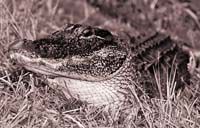Project would bring world of dinosaurs alive
| A fellow much like this one could end up being a resident at the Mesozoic gardens which are part of the proposed expansion of the CEU Prehistoric Museum. |
Visitors to Carbon County may one day be able to step into a garden alive with the sights, sounds and smells of the world when dinosaurs reigned.
Price already houses one of the few museums dedicated primarily to paleontology. And now an ambitious $6.5 million vision could bring to life a massive structure reminiscent of a modern-day Mayan ruin to the hills above the city that will re-create the physical world inhabited by the giants.
“This could become a major research site for geology, paleontology and archaeology” said Reese Barrick, director of the College of Eastern Utah Prehistoric Museum. “People who would be recruited to work would wear two hats, they would teach and curate.”
Barrick said the proposed Mesozoic gardens, which is just one part of an overall museum expansion, would re-create the physical environment of the era.
“This will be a living dinosaur environment,” he said.
Plans include finding and utilizing plants that are genetically linked to the time of the dinosaurs such as ginko, creating water features that will house live creatures that have not changed much since the times they shared the earth with their enormous cousins.
“We will have soft shell turtles, crocodiles and gar fish,” Barrick said.
While plans to expand the prehistoric museum were already on the drawing the board, the idea for the gardens were in some part inspired by an Australian organization. According to Barrick, Global Studies Institute based in Queensland, Australia showed some interest in setting up a field center for paleontology.
“One of the ideas was an evolutionary garden,” Barrick said. “When I found out about this, I thought that it would be a perfect fit for us.”
According to materials from the organization’s Web site, GSI mission is to provide “networking between institutions, professors and specialists to provide an effective experiential learning facility to students from all walks of life.”
The marriage of GSI’s interest in the area and the existing vision of expanding the museum gave birth to what is called the phase one of the expansion -the Mesozoic gardens on a nearly 20-acre campus that’s located just north of the Price River Water Improvement District headquarters.
“We have 19.5 acres that were donated to the college,” Barrick said.
While the research and teaching possibilities may abound from such a facility, Barrick said he sees an even bigger and broader benefit for the whole area.
“This could be a huge tourist draw,” he said. “It will be one -of-a-kind.”
He said that it might actually be the impetus for economic growth in Carbon County and Price.
“It might create a need for more restaurants and bookstores downtown,” Barrick said.
While he is looking far ahead, Barrick is still very anchored in the reality of how to move forward in the very preliminary steps.
Barrick said that the next step is to raise $100,000 to put the project out to bid. He said later on down the line that the museum hopes to work with the county to approach the Utah Permanent Community Impact Board for funding help to construct the facility.
“I hope the community will support the project because it can have so many uses, as a research tool, as an educational venue allowing school kids to have a hands on experience with the Mesozoic age,” he said. “It will be a museum, a zoo and gardens.”

